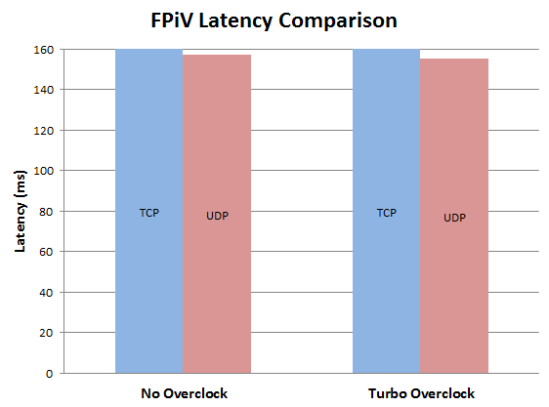Extract
Various issues have kept me grounded for a couple of months, but I have managed to get some bench testing done. Two things I wanted to test were a comparison of TCP versus UDP for the transport stream and the effect of overclocking the Pi. In both cases the results were disappointing with only minimal reductions in overall latency.
Setup
The test environment was set up the same as previously, with the camera pointing at the laptop screen. The camera was positioned so that at least ten iterations of the image was visible at once. I used the LED on my phone with a flashlight app for measurement indicator. The tests were run with the no overclocking and then the maximum (Turbo) setting available in raspi-config.
The scripts for transmitting and receiving the video stream are shown below.
A GoPro 3 Black was used to record the screen at 120 fps.
TCP – Pi Transmitter Script
#!/bin/sh cat $0 # Zero duration is continuous DURATION=0 WIDTH=1280 HEIGHT=720 FRAMERATE=30 BITRATE=2500000 IP=$(ip -o addr show wlan0 | sed -n 's/.*inet \([0-9.]*\)\/.. .*/\1/p') PORT=5000 /opt/vc/bin/raspivid -t $DURATION -w $WIDTH -h $HEIGHT -fps $FRAMERATE -b $BITRATE -n -o - | gst-launch-1.0 -v fdsrc ! h264parse ! rtph264pay config-interval=1 pt=96 ! gdppay ! tcpserversink host=$IP port=$PORT
TCP – Laptop Receiver and Recording Script
#!/bin/bash source ./settings.conf NOW=`date +%Y%m%d%H%M%S` FILENAME=$NOW-Rx.ts gst-launch-1.0 -v tcpclientsrc host=$IP port=$TCPPORT ! \ gdpdepay ! rtph264depay ! \ h264parse config-interval=96 ! \ tee name=t ! queue ! \ video/x-h264, framerate=25/1 ! avdec_h264 ! videoconvert ! autovideosink sync=false t. ! \ queue ! mpegtsmux ! filesink location=$FILENAME
UDP – Pi Transmitter Script
#!/bin/sh cat $0 # Zero duration is continuous DURATION=0 WIDTH=1280 HEIGHT=720 FRAMERATE=48 BITRATE=2500000 IP=$(ip -o addr show wlan0 | sed -n 's/.*inet \([0-9.]*\)\/.. .*/\1/p') #Edit the address below to match the receiving computer TARGETIP=192.168.42.26 UDPPORT=5001 NOW=`date +%Y%m%d%H%M%S` FILENAME=$NOW-Tx.h264 /opt/vc/bin/raspivid -t $DURATION -w $WIDTH -h $HEIGHT -fps $FRAMERATE -b $BITRATE -n -o - | gst-launch-1.0 -v fdsrc ! h264parse ! rtph264pay config-interval=1 pt=96 ! udpsink host=$TARGETIP port=$UDPPORT
UDP – Laptop Receiver and Recording Script
#!/bin/bash source ./settings.conf NOW=`date +%Y%m%d%H%M%S` FILENAME=$NOW-Rx.ts gst-launch-1.0 -v udpsrc port=$UDPPORT \ caps='application/x-rtp, media=(string)video, clock-rate=(int)90000, encoding-name=(string)H264' ! \ rtph264depay ! h264parse config-interval=96 ! \ tee name=t ! queue ! \ video/x-h264, framerate=48/1 ! avdec_h264 ! videoconvert ! autovideosink sync=false t. ! \ queue ! mpegtsmux ! filesink location=$FILENAME
settings.conf
#!/bin/bash export IP=192.168.42.1 export TCPPORT=5000 export UDPPORT=5001 export FRAMERATE=25
Results
The GoPro video was analyzed in Sony Movie Studio 11 to establish the number of frames between the LED switch on and the tenth iteration switch on. This value was then divided by 120 to get the number of seconds for ten iterations, divided by 10 to get the number of seconds per iteration and finally multiplied by 1000 to get the latency in milliseconds.
- TCP – No Overclock – 160 ms
- TCP – Turbo Overclock – 160 ms
- UDP – No Overclock – 157 ms
- UDP – Turbo Overclock – 155 ms
As you can see from the graph, there is very little difference between the values. Switching to UDP gives a 3ms reduction in latency over TCP and the Turbo overclock removes another 2ms. TCP doesn’t seem to benefit from overclocking at all.
Conclusion
Based on these results, I plan to switch future testing to UDP. I’m not going to bother overclocking though, prefering the lower current draw and better long term stability of no overclocking.


You must be logged in to post a comment.